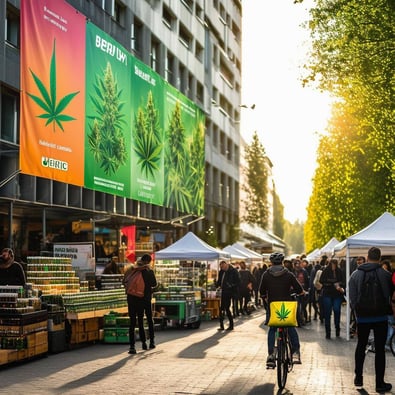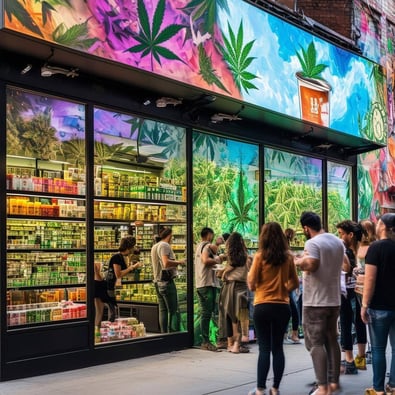Cannabis terpenes let brewers impart a 'whiff of cannabis' while the beverage itself still tastes of beer.
Greater Good Imperial Brewing Co. had a clearheaded idea for the experience it hoped to capture by infusing its IPA “Pulp Daddy” with cannabis terpenes.
‘There’s no THC. There’s no CBD. What we’re after are the aromas,” said Chris Zampa, Greater Good’s new vice president of brewing operations. “What I really wanted to do, and the way I described it to the team was, it’s opening a bag of marijuana: You get that initial aroma, and then it stops. We wanted it all in the aroma, while the beer still tastes like a beer.”
But with cannabis terpenes – the source of marijuana’s flavors and aromatics – a little goes a long way. While one set of terpenes could provide intense floral, piney and citrus aromas, another may impart spice, musk and earthiness.
The brewer wanted each can of “Dank Pulp Daddy” to impart just a subtle whiff of cannabis, rather than having you saddle up on the couch for a marathon session of snacks and episodes of “Ancient Aliens.”
Greater Good started with 22 different samples of water-soluble terpenes, developed by a California company specifically for brewing. The company can extract terpenes from cannabis while stripping away any of the psychoactive elements.
The testing process first involved seeing how varying doses, dropped by pipette into glasses of Pulp Daddy, affected the smell of the beer. Most everyone on staff joined in, and for a couple days, the aromas around the Millbrook Street taproom were more akin to a dispensary than a brewery.
After the sniff tests, Zampa and the brew team poured cylinders of the liquid terpenes into a brew tank and tasted the results. He said they quickly determined “there’s a fine line between not being able to pick up the flavors at all and being like, ‘Whoa.’”
Yes, that Pineapple Express
Ultimately, Greater Good picked terpenes from a marijuana strain made famous by the classic comedy bearing its name: Pineapple Express.
According to the website Leafly, which provides reviews and information on cannabis strains, the strain carries terpenes with names like “caryophyllene,” “limonene” and “Ocimene” that combine for a “punch to your pallet with bright citrus notes infused with pineapple and earthy pine.”
Last week I sat with Zampa to try Dank Pulp Daddy, available on tap, in four-packs and within Greater Good’s new variety pack of Pulp Daddy. I detected the slightest pop of resinous cannabis on the nose that faded into the IPA’s signature pineapple and orange. To my palate, the flavors brought more pine up front than the original Pulp Daddy, along with a smooth lemony finish.
Zampa told me the terpenes and hops in the beer should blend together without them overwhelming each other. “The terpenes bring out the citrusy, juicy hop profile that most of our beers have from the Citra and Mosaic hops,” he said.
He showed me the tiny sample vial of Pineapple Express terpenes the brewery had to test from, warning me not to inhale it. Even holding the cap up to my nostrils was enough to pick up the sharp pine and citrus.
To brew Dank Pulp Daddy, Greater Good added about a gallon of the terpenes, which resembled a milky liquid, per 60 barrels of beer into the fermentation tank late in the brew process. Much the same way dry-hopping enhances hop aromas without extra bitterness, saving the terpenes for near the end of the brew helped Greater Good pull out the terps’ aromatics while avoiding any overpowering flavors.
Terpenes growing on brewers
Beers with terpenes sit far from even the fringe of the mainstream beer market. But whether derived from cannabis or its cousin hops, they represent for brewers exciting ingredients to experiment with.
For consumers, these organic compounds – found in the essential oils of most plants – could provide, at least for now, another legal pathway for the brewing industry and the marijuana industry to collaborate.
“Breweries are always looking for the next big thing,” Zampa told me. “The two, marijuana and beer, marry quite well.”
Unfortunately, they cannot legally marry yet, as federal law prohibits using cannabis in beer.
The terpenes derived from cannabis, however, has been allowed, as long as they do not contain any traces of THC or CBD.
Getting a beer with terpenes approved has tended to take longer than normal, as the Alcohol and Tobacco Tax and Trade Bureau performs a more rigorous review.
Three years ago, Mass Bay Brewing Co.’s Clown Shoes released “Rainbows are Real,” an IPA with Beta-Pinene and Linalool, two terpenes commonly found in cannabis, with the TTB approval process stretching on for 10 months, according to the trade magazine Beverage Dynamics.
Clown Shoes balanced how it broadcasted the brew’s connection with cannabis, calling the terpenes simply aromatic compounds derived from natural botanical sources, while at the same time printing a label that depicts the kind of psychedelic imagery normally associated with weed.
Greater Good unveiled Dank Pulp Daddy on April 20 – 4/20 – a special day in cannabis culture. But apart from a nod to the holiday, Zampa said, the brewery didn’t want the beer’s marketing to scream marijuana.
“We didn’t want to lean on the association with marijuana,” he said. “It’s about showcasing Pulp Daddy.”
More broadly, recent examples of terpene-infused brews tend to play up the cannabis component.
In April, along with the release “Hopsmoker,” an imperial IPA with terpenes, Braintree’s Widowmaker Brewing had a “bong glass” for sale to go along with the beer.
And Widowmaker last year made “Welcome to Grassachusetts,” an IPA with terpenes brewed in collaboration with Rolling Releaf, a cannabis delivery service.
Breweries, dispensaries don’t see collaborations as pipe dreams
Cannabis purveyors would welcome such collaborations, according to Jennifer Ngo, chief of staff at Bud’s Goods & Provisions, a cannabis dispensary on West Boylston Street.
From Greater Good, it is a roughly 10-minute walk across Gold Star Boulevard to Bud’s, formerly home to the city’s first skate shop. Hoping to learn more about terpenes, I met Ngo on a busy Friday afternoon at the dispensary. We chatted in a corner, near brightly-lit displays of products like cans of cannabis-infused seltzers.
“There’s a lot of interplay between terpenes out in nature,” she told me. “Caryophyllene, for example, is a terpene found in pepper, but it’s also found in cannabis. When you crack your pepper over your food, that scent you’re getting is caryophyllene.”
Ngo pointed out a framed infographic on the wall indicating the most common terpenes found in cannabis. On average, according to the cannabis seed seller Humboldt Seed Company, every cannabis plant has a combination of about 40 terpenes, and over 200 have been identified so far.
Bud’s displays these colorful posters at all three of its stores, an ongoing effort to illustrate for customers and staff the multitude of flavors and aromas that different terpenes bestow.
“We look at this as a long-term investment in education for our customers,” she told me. “Worcester has been open for three years, and in that time, as far as terpenes are concerned, we’ve been seeing a lot more of our customers … paying attention to them, because they’re learning more about how terpenes affect their cannabis experience.”
With breweries now highlighting terpenes in their beer, Ngo believes there’s an opportunity for the general public to learn more about the cannabis industry. Bud’s would welcome a collaboration down the line with Greater Good, she said, as there is already mutual respect between the two companies.
“Overall, we want break the stigma around cannabis. Yes, cannabis is a drug. Alcohol is also a drug that people willingly take,” she said. “Being able to partner with a brewery would mean we’re on track to becoming normal. We just want to be treated like another business.”




